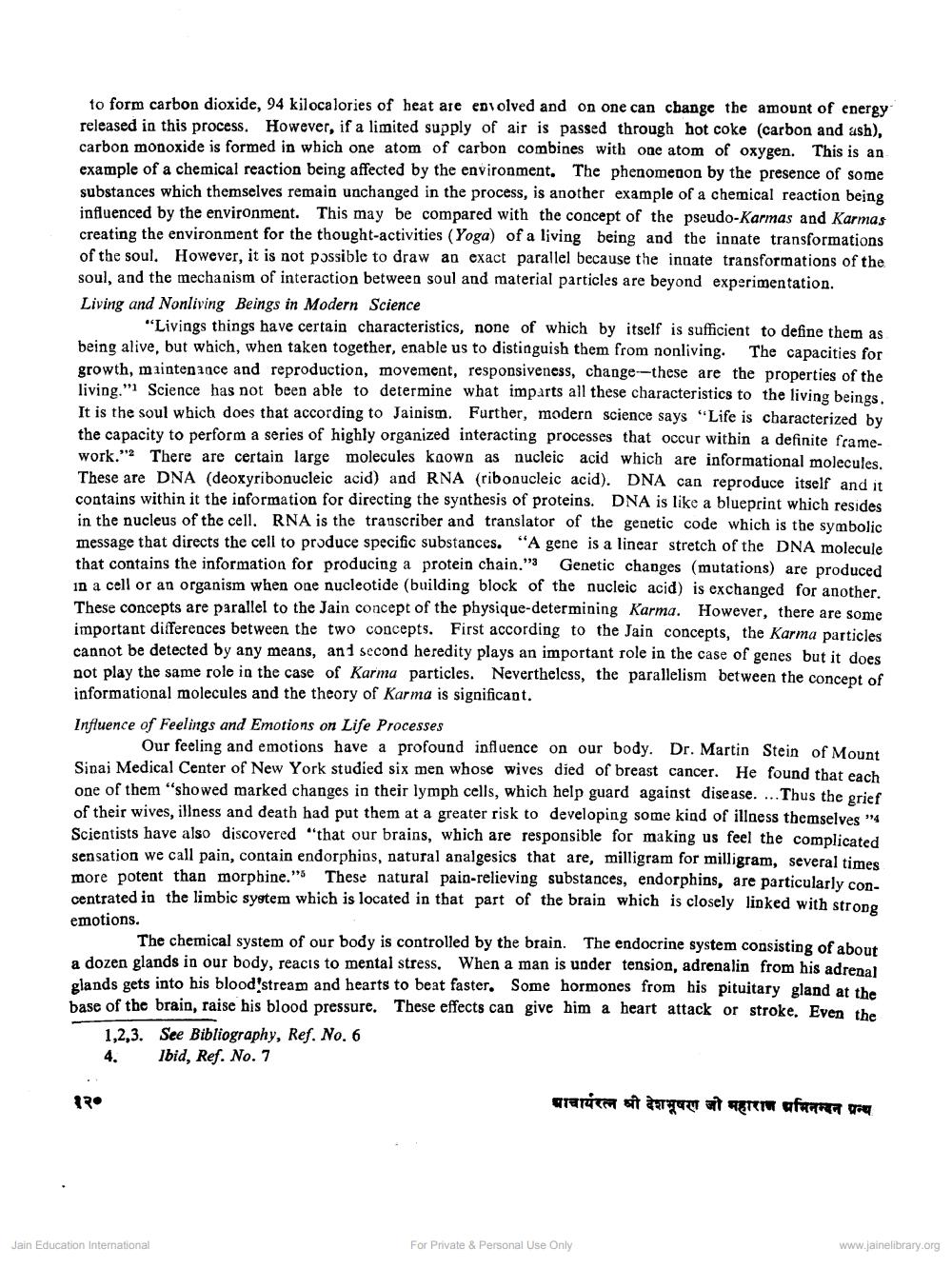Book Title: How Karma theory relates to Modern Science Author(s): Dulichand Jain Publisher: Z_Deshbhushanji_Maharaj_Abhinandan_Granth_012045.pdf View full book textPage 9
________________ to form carbon dioxide, 94 kilocalories of heat are evolved and on one can change the amount of energy released in this process. However, if a limited supply of air is passed through hot coke (carbon and ash), carbon monoxide is formed in which one atom of carbon combines with one atom of oxygen. This is an example of a chemical reaction being affected by the environment. The phenomenon by the presence of some substances which themselves remain unchanged in the process, is another example of a chemical reaction being influenced by the environment. This may be compared with the concept of the pseudo-Karmas and Karmas creating the environment for the thought-activities (Yoga) of a living being and the innate transformations of the soul. However, it is not possible to draw an exact parallel because the innate transformations of the soul, and the mechanism of interaction between soul and material particles are beyond experimentation. Living and Nonliving Beings in Modern Science "Livings things have certain characteristics, none of which by itself is sufficient to define them as being alive, but which, when taken together, enable us to distinguish them from nonliving. The capacities for growth, maintenance and reproduction, movement, responsiveness, change--these are the properties of the living.". Science has not been able to determine what imparts all these characteristics to the living beings. It is the soul which does that according to Jainism. Further, modern science says "Life is characterized by the capacity to perform a series of highly organized interacting processes that occur within a definite framework."2 There are certain large molecules kaown as nucleic acid which are informational molecules. These are DNA (deoxyribonucleic acid) and RNA (ribonucleic acid). DNA can reproduce itself and it contains within it the information for directing the synthesis of proteins. DNA is like a blueprint which resides in the nucleus of the cell. RNA is the transcriber and translator of the genetic code which is the symbolic message that directs the cell to produce specific substances. "A gene is a linear stretch of the DNA molecule that contains the information for producing a protein chain."3 Genetic changes (mutations) are produced in a cell or an organism when one nucleotide (building block of the nucleic acid) is exchanged for another. These concepts are parallel to the Jain concept of the physique-determining Karma. However, there are some important differences between the two concepts. First according to the Jain concepts, the Karma particles cannot be detected by any means, and second heredity plays an important role in the case of genes but it does not play the same role in the case of Karma particles. Nevertheless, the parallelism between the concept of informational molecules and the theory of Karma is significant. Influence of Feelings and Emotions on Life Processes Our feeling and emotions have a profound influence on our body. Dr. Martin Stein of Mount Sinai Medical Center of New York studied six men whose wives died of breast cancer. He found that each one of them "showed marked changes in their lymph cells, which help guard against disease. ... Thus the grief of their wives, illness and death had put them at a greater risk to developing some kind of illness themselves "4 Scientists have also discovered "that our brains, which are responsible for making us feel the complicated sensation we call pain, contain endorphins, natural analgesics that are, milligram for milligram, several times more potent than morphine." These natural pain-relieving substances, endorphins, are particularly con. centrated in the limbic system which is located in that part of the brain which is closely linked with strong emotions. The chemical system of our body is controlled by the brain. The endocrine system consisting of about a dozen glands in our body, reacts to mental stress. When a man is under tension, adrenalin from his adrenal glands gets into his bloodstream and hearts to beat faster. Some hormones from his pituitary gland at the base of the brain, raise his blood pressure. These effects can give him a heart attack or stroke. Even the 1,2,3. See Bibliography, Ref. No. 6 4. Ibid, Ref. No. 7 170 पाचार्यरत्न श्री देशभूषण जी महाराज अमिनन्दन अन्य Jain Education International For Private & Personal Use Only www.jainelibrary.orgPage Navigation
1 ... 7 8 9 10 11
